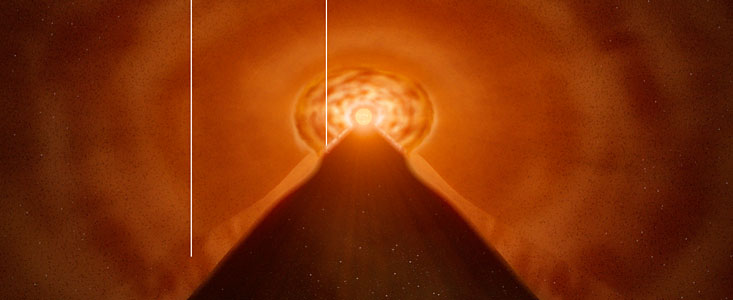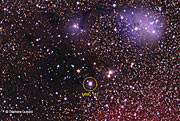Nota de prensa
The Growing-up of a Star
VLT decodes the innermost surroundings of a star in the maturing
29 de Enero de 2008
Using ESO's Very Large Telescope Interferometer, astronomers have probed the inner parts of the disc of material surrounding a young stellar object, witnessing how it gains its mass before becoming an adult.
The astronomers had a close look at the object known as MWC 147, lying about 2,600 light years away towards the constellation of Monoceros ('the Unicorn'). MWC 147 belongs to the family of Herbig Ae/Be objects. These have a few times the mass of our Sun and are still forming, increasing in mass by swallowing material present in a surrounding disc.
MWC 147 is less than half a million years old. If one associated the middle-aged, 4.6 billion year old Sun with a person in his early forties, MWC 147 would be a 1-day-old baby [1].
The morphology of the inner environment of these young stars is however a matter of debate and knowledge of it is important to better understand how stars and their cortège of planets form.
The astronomers Stefan Kraus, Thomas Preibisch, and Keiichi Ohnaka have used the four 8.2-m Unit Telescopes of ESO's Very Large Telescope to this purpose, combining the light from two or three telescopes with the MIDI and AMBER instruments.
"With our VLTI/MIDI and VLTI/AMBER observations of MWC147, we combine, for the first time, near- and mid-infrared interferometric observations of a Herbig Ae/Be star, providing a measurement of the disc size over a wide wavelength range [2]," said Stefan Kraus, lead-author of the paper reporting the results. "Different wavelength regimes trace different temperatures, allowing us to probe the disc's geometry on the smaller scale, but also to constrain how the temperature changes with the distance from the star."
The near-infrared observations probe hot material with temperatures of up to a few thousand degrees in the innermost disc regions, while the mid-infrared observations trace cooler dust further out in the disc.
The observations show that the temperature changes with radius are much steeper than predicted by the currently favoured models, indicating that most of the near-infrared emission emerges from hot material located very close to the star, that is, within one or two times the Earth-Sun distance (1-2 AU). This also implies that dust cannot exist so close to the star, since the strong energy radiated by the star heats and ultimately destroys the dust grains.
"We have performed detailed numerical simulations to understand these observations and reached the conclusion that we observe not only the outer dust disc, but also measure strong emission from a hot inner gaseous disc. This suggests that the disc is not a passive one, simply reprocessing the light from the star," explained Kraus. "Instead, the disc is active, and we see the material, which is just transported from the outer disc parts towards the forming star."
The best-fit model is that of a disc extending out to 100 AU, with the star increasing in mass at a rate of seven millionths of a solar mass per year.
"Our study demonstrates the power of ESO's VLTI to probe the inner structure of discs around young stars and to reveal how stars reach their final mass," said Stefan Kraus.
Notas
[1]: Being 6.6 times more massive than the Sun, however, MWC 147 will only live for about 35 million years, or to draw again the comparison with a person, about 100 days, instead of the 80 year equivalent of our Sun.
[2]: MIDI is the mid-infrared instrument of the VLT interferometer. It operates between 8 and 13 microns. AMBER observes in the near-infrared, from 1 to 2.4 microns.
Información adicional
The authors report their results in a paper in the Astrophysical Journal ("Detection of an inner gaseous component in a Herbig Be star accretion disk: Near- and mid-infrared spectro-interferometry and radiative transfer modeling of MWC 147", by Stefan Kraus, Thomas Preibisch, Keichii Ohnaka").
Contactos
Stefan Kraus
Max-Planck-Institute for Radio Astronomy
Bonn, Germany
Teléfono: +49 (0)228 525-395
Correo electrónico: skraus@mpifr-bonn.mpg.de
Acerca de la nota de prensa
| Nota de prensa No.: | eso0803 |
| Legacy ID: | PR 03/08 |
| Nombre: | MWC 147 |
| Tipo: | Milky Way : Star : Evolutionary Stage : Young Stellar Object |
| Facility: | Very Large Telescope, Very Large Telescope Interferometer |
| Instruments: | AMBER, MIDI |
| Science data: | 2008ApJ...676..490K |
Our use of Cookies
We use cookies that are essential for accessing our websites and using our services. We also use cookies to analyse, measure and improve our websites’ performance, to enable content sharing via social media and to display media content hosted on third-party platforms.
ESO Cookies Policy
The European Organisation for Astronomical Research in the Southern Hemisphere (ESO) is the pre-eminent intergovernmental science and technology organisation in astronomy. It carries out an ambitious programme focused on the design, construction and operation of powerful ground-based observing facilities for astronomy.
This Cookies Policy is intended to provide clarity by outlining the cookies used on the ESO public websites, their functions, the options you have for controlling them, and the ways you can contact us for additional details.
What are cookies?
Cookies are small pieces of data stored on your device by websites you visit. They serve various purposes, such as remembering login credentials and preferences and enhance your browsing experience.
Categories of cookies we use
Essential cookies (always active): These cookies are strictly necessary for the proper functioning of our website. Without these cookies, the website cannot operate correctly, and certain services, such as logging in or accessing secure areas, may not be available; because they are essential for the website’s operation, they cannot be disabled.
Functional Cookies: These cookies enhance your browsing experience by enabling additional features and personalization, such as remembering your preferences and settings. While not strictly necessary for the website to function, they improve usability and convenience; these cookies are only placed if you provide your consent.
Analytics cookies: These cookies collect information about how visitors interact with our website, such as which pages are visited most often and how users navigate the site. This data helps us improve website performance, optimize content, and enhance the user experience; these cookies are only placed if you provide your consent. We use the following analytics cookies.
Matomo Cookies:
This website uses Matomo (formerly Piwik), an open source software which enables the statistical analysis of website visits. Matomo uses cookies (text files) which are saved on your computer and which allow us to analyze how you use our website. The website user information generated by the cookies will only be saved on the servers of our IT Department. We use this information to analyze www.eso.org visits and to prepare reports on website activities. These data will not be disclosed to third parties.
On behalf of ESO, Matomo will use this information for the purpose of evaluating your use of the website, compiling reports on website activity and providing other services relating to website activity and internet usage.
Matomo cookies settings:
Additional Third-party cookies on ESO websites: some of our pages display content from external providers, e.g. YouTube.
Such third-party services are outside of ESO control and may, at any time, change their terms of service, use of cookies, etc.
YouTube: Some videos on the ESO website are embedded from ESO’s official YouTube channel. We have enabled YouTube’s privacy-enhanced mode, meaning that no cookies are set unless the user actively clicks on the video to play it. Additionally, in this mode, YouTube does not store any personally identifiable cookie data for embedded video playbacks. For more details, please refer to YouTube’s embedding videos information page.
Cookies can also be classified based on the following elements.
Regarding the domain, there are:
- First-party cookies, set by the website you are currently visiting. They are stored by the same domain that you are browsing and are used to enhance your experience on that site;
- Third-party cookies, set by a domain other than the one you are currently visiting.
As for their duration, cookies can be:
- Browser-session cookies, which are deleted when the user closes the browser;
- Stored cookies, which stay on the user's device for a predetermined period of time.
How to manage cookies
Cookie settings: You can modify your cookie choices for the ESO webpages at any time by clicking on the link Cookie settings at the bottom of any page.
In your browser: If you wish to delete cookies or instruct your browser to delete or block cookies by default, please visit the help pages of your browser:
Please be aware that if you delete or decline cookies, certain functionalities of our website may be not be available and your browsing experience may be affected.
You can set most browsers to prevent any cookies being placed on your device, but you may then have to manually adjust some preferences every time you visit a site/page. And some services and functionalities may not work properly at all (e.g. profile logging-in, shop check out).
Updates to the ESO Cookies Policy
The ESO Cookies Policy may be subject to future updates, which will be made available on this page.
Additional information
For any queries related to cookies, please contact: pdprATesoDOTorg.
As ESO public webpages are managed by our Department of Communication, your questions will be dealt with the support of the said Department.



